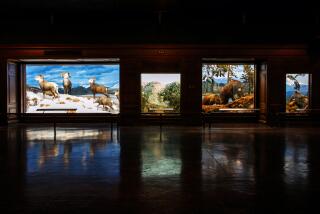ART REVIEW : Durham’s Works Explore the Edge of Absurdity
Jimmie Durham is a Cherokee Indian--though not recognized as such by the U.S. government since he lacks an “official” registration number. It is, therefore, somehow fitting that Durham makes art that is absurd and about absurdity--the absurdity of all brands of “officialdom”; the absurdity of being a native of an America where natives are regularly conjured as aliens; and, of course, the absurdity of making art.
“It’s Not Like Max Ernst at All,” a work that is showcased in Durham’s first Los Angeles show, is a good place to begin thinking about Durham’s work. A rudimentary animal effigy constructed out of pieces of raw wood covered in glossy gray paint, it refers to one of the late Surrealist artist’s best-known sculptural works.
Like Ernst, Durham is involved in the systematic transmogrification of found objects and images--wooden planks, old diagrams, bits of branches, industrial pipes and oddly shaped pieces of animal hide.
Yet where the Surrealists worked their materials toward effecting crises of consciousness, Durham is already well-lodged within that space--of crisis, contradiction and no small amount of paranoia. And whereas Ernst tried to forge a link with the “primitive” so as to tap into “authentic,” unmediated experience, Durham finds himself burdened with the legacy of primitivism, one of Euro-America’s most insidious constructs.
This show at L.A. Louver, titled “Various Gates and Escape Routes,” is about the possibility of navigating a way out. About this, Durham is characteristically ironic. His wit is sharply honed, but it doesn’t cut too deeply. It explores the state of things, without seeking to exact revenge. In this, it is less a didactic than a personal exercise.
Constructed as a narrative, the exhibition has a beginning, middle and end. At the entrance is a “metal detector,” through which one must, in theory, pass; a rickety wooden structure, it doesn’t function except as an emptied-out signifier of state authority. Around the corner are two small mirrors mounted to a branch, as if to help you watch your ever-vulnerable back. And at the close is a slot machine/guillotine, which automatically returns every quarter; emblazoned across the front are the words, “You Have Another Chance.”
In between are various assemblages that dip into the fetish character of American Indian art while defying the host of stereotypes that accompany it. One could think of the work as minimal (and given Durham’s earlier work, it is extremely lean), but it is better classified as stubborn, insolent, even mocking. Its minimalism is not a matter of form, but a manner of resisting the relegation of American Indian art to roadside curio shops and natural history museums, the stuff of which the artist deftly denaturalizes. With, among other things, a pipe imprinted with the word Apache , Durham puts the colonialist impulse on display instead, and joins in the long process of settings things right.
* “Various Gates and Escape Routes,” L.A. Louver, 77 Market St., Venice, (310) 822-4955. Closed Sun. & Mon., through Oct. 2.
More to Read
The biggest entertainment stories
Get our big stories about Hollywood, film, television, music, arts, culture and more right in your inbox as soon as they publish.
You may occasionally receive promotional content from the Los Angeles Times.










